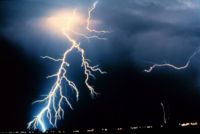Electricity
 From Conservapedia - Reading time: 3 min
From Conservapedia - Reading time: 3 min
Electricity is energy that can be converted to heat, light, motion and many other physical effects through the force produced in the attraction or repulsion between charged particles. It is measured in terms of electric charge, current, voltage, and resistance. A basic element of electricity is the electric circuit. A circuit is a closed path that allows for movement of charges. Current is the name given to the movement of charges. The study of electricity involves the behavior of charges, current and voltage with the components that make up the electrical circuit. Electrical engineering has allowed many practical advances to be made, such as replacing steam powered trains with more efficient electric trains.
Contents
Polarity[edit]
All materials that are known contain two basic components of electric charge: the proton and the electron. The proton is a particle with a single positive charge, and the electron has a single negative charge.
It is the arrangement of electrons and protons as basic particles of electricity that determines the electrical characteristics of substances. Although all matter has protons and electrons, most materials do not exhibit any evidence of electrical activity, because the protons and electrons arranged in balanced ways. In order to use electricity to do work, the material must contain electrons that are free to move from atom to atom. A battery can do electrical work because a chemical process takes place when it is part of a completed circuit moves electrons towards its negative terminal and conversely, creates a lack of them at its positive terminal. Electrons then flow through the circuit to keep balancing out this chemical process.
Some molecules are said to be "polarized" because their atomic arrangement and electron sharing causes a net charge to develop on opposite sides. Water is a classic example of this, with the electrons from the hydrogen atoms "spending more time" in proximity to the oxygen atoms. Since the hydrogen atoms are "attached" to the oxygen asymmetrically (instead of being at opposite sides of the oxygen, the angle between their "attachment points" is 108 degrees), one end of the water molecule carries a positive charge and the other a negative one. This polarization results in water's ability to dissolve salts, and display acidic or basic characteristics.
The Structure of an Atom Determines its Electrical Characteristics[edit]
Although there are many possible ways protons and electrons could group themselves, they assemble in specific combinations that usually result in stable arrangement. An arrangement of protons, electrons, and often neutrons creates an atom of an element. Electrons orbit the nucleus of protons and neutrons at specific intervals, called "shells" or "energy levels." Each shell has a maximum number of electrons for stability. It is the structure of the outermost shell of electrons in an element that determines how well it conducts electricity and its magnetic properties. If an element has fewer than the maximum number of electrons in its outermost shell (typically eight), for example silicon which has only four electrons, then it can conduct electricity to some degree; the elements that have one electron in their outermost shell conduct electricity best. Gold, silver, and copper are the best conductors of electricity because their outermost electron shell has only one electron, and this allows the freest flow of electrical current because the opposition of an atom of these elements from taking on or loosing electrons is low. Materials with electrons that tend to stay in their own orbits are called insulators, because they do not conduct electricity very well. However, these materials (except for the inert gases) can also take up extra electrons to complete their outer shells, and become negatively charged; they hold on to and store electrical charge, unlike conductors. Insulating materials like glass, plastic, rubber, paper, air, and mica are called dielectrics, meaning that they can take on and hold electrical charge. Insulators are useful when it is necessary to prevent current flow. They are also used in applications for storing electrical charge, as in capacitors, since a good conductor of electricity can only store charge on its surface, limiting the amount. Materials that can conduct more electrical charge than insulators, but less than conductors are called semiconductors. Carbon, silicon, and germanium are commonly used for transistors, diodes and other semiconductor components, with silicon being the most widely used.
Electrical Power[edit]
In physics, electrical power is the product of current and voltage (P = IV), and is commonly measured in Watts. Current can be alternating or direct. The electrical power generation market, which provides useful power for residential, commercial, and industrial use, is commonly divided into three segments: generation, transmission, and distribution. Electrical power can be generated in large scale power plants or on a smaller scale for distributed power applications.
Resources[edit]
Grob, Bertand Basic Electronics Fifth edition, 1984
 KSF
KSF